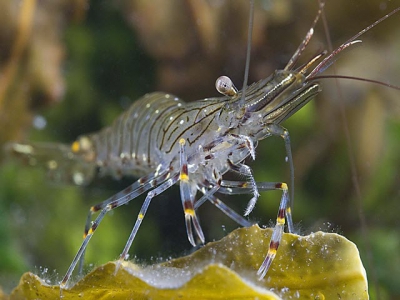Shrimp diseases - Nutritional Diseases- Poor and reduced growth

The yield of shrimps is directly proportional to the quantity and quality of feed consumed by them. The quality refers to the presence of all the nutrients and subnutrients in the required amount for growth and development of the shrimps. Shrimps require six nutrients and about 30 sub/micronutrients. Subnutrients are the individual amino acids, vitamins, minerals and the fatty acids. Each one of them is very essential for the growth and development of shrimps. In the case of shrimps, being a very short term crop, any deficiency in any one of the nutrients will seriously affect the growth and development. At every stage each and every nutrient or subnutrient required has to be given in time. In a long term crop there is time to make up any nutritional deficiency that may be occurring at some time or other during the growing period.
Often commercial feed manufacturers, being so much preoccupied with maximum profit with minimum expenditure, do not take enough care to make sure that all the nutrients and sub nutrients are present in the feed. Therefore in a commercial shrimp rearing pond under intensive and high density stocking conditions the chances of occurring nutritional deficiencies are very high.
Poorly fed shrimps will lose their normal full and robust appearance. The shell becomes thin and flexible. Molting is delayed and as a result the whole growth and development process is retarded. Besides certain specific diseases related to poor nutrition appear.
Protein deficiency is directly linked with the development of the muscles and flesh and the proteins required for the shrimps are made of ten amino acids which the shrimps are unable to synthesis and hence they have to be supplied through the feed. Shrimps require very high percentage (35- 45 %) of protein in the field.
Shrimps require phospholipids rich in posphotidyl choline and phosphotidyl inositol for normal growth, moulting, metamorphosis and maturation. Consequently the spawning, hatchability of eggs and larval survival are affected.
Soft shell disease is commonly seen among the juveniles and adults. The infected shrimp will have soft and thin exoskeleton which appears bluish. They exhibit greater cannibalistic tendencies. The subnutrients directly responsible for this disease are calcium, potassium and phosphorus. About 20 % of the energy absorbed is used for the formation of exoskeleton. Therefore shrimps require very high energy feed and if the energy is less the exoskeleton will become soft shelled.
Vitamin A is required for the health and wellbeing of the internal and external epithelial tissues. Vitamin B has several forms and they are all playing major role in one or other metabolic activities. Vitamin C is required for the chitin formation. It also causes reduced food intake, poor conversion of food and high incidence of post moult death. Vitamin D is involved in the calcium metabolism and Vitamin E acts as an anti-oxidant in the feed besides playing a major role in the reproductive cycle.
Related news
 A study of Zoea-2 Syndrome in hatcheries in India, part 3
A study of Zoea-2 Syndrome in hatcheries in India, part 3 Perspectives and recommendations for Pacific white shrimp culture
 Balanced protein/energy diet may offer low-cost feed for farmed shrimp
Balanced protein/energy diet may offer low-cost feed for farmed shrimp The correct dietary protein and energy ratio may support farmed shrimp production, growth and offer a lower-cost feed, say researchers.
 Krill meal performs well in shrimp feed experiments
Krill meal performs well in shrimp feed experiments Even low inclusion rates improve feed efficiency for juvenile whiteleg shrimp reared in high salinities
 Retrofitting shrimp farms to recirculating systems
Retrofitting shrimp farms to recirculating systems For several years, our team has collaborated in the development and fine-tuning of technology to retrofit and “close” semi-intensive shrimp farms with large
 Microalgae into medicine: Biotech startup targets shrimp, salmon diseases
Microalgae into medicine: Biotech startup targets shrimp, salmon diseases MicroSynbiotiX developing versatile oral vaccines intended for wide range of species. Microalgae into medicine: Biotech startup targets shrimp, salmon diseases